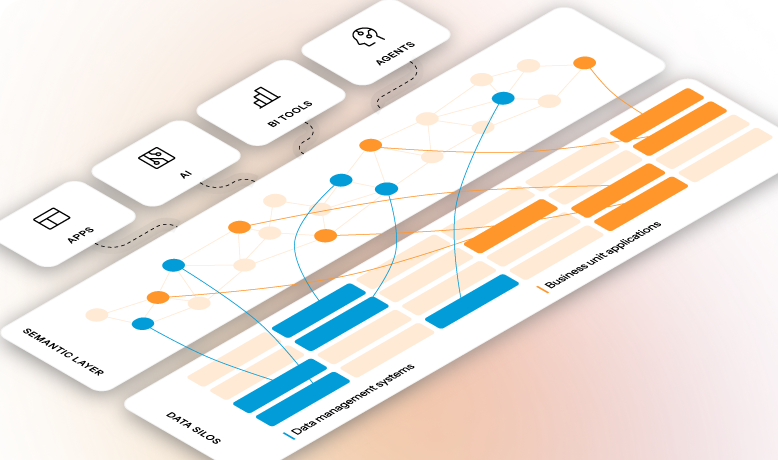
Knowledge Graphs and Ontologies: A Primer
%2520(2).png)
The future of decision intelligence is being rewritten—not by outdated models or conventional systems, but by innovative technologies that unlock the full potential of data.
Leading this transformation are Advanced AI-enabled platforms that leverage knowledge graphs and ontologies to revolutionize how enterprises harness their data to uncover hidden patterns and relationships, providing not just the ‘what,’ but the ‘why’.
So, why leverage knowledge graphs and ontologies?
First, let's look at the general concepts, and in subsequent posts, we'll explore specific uses of graphs in enterprise analytics and AI.
Knowledge graphs break down silos, unifying diverse data sources for smarter, more actionable insights. Ontologies, in turn, provide a framework to understand your organization's unique knowledge, adding context and depth to the data.
Key benefits:
- Breaking Data Silos: An ontology-based approach can connect and harmonize data from different data systems, eliminating information barriers and promoting collaboration.
- Enhanced Understanding by humans and language models: Visual representation of relationships provides a clearer understanding of complex data and its interdependencies. Humans can understand it, as can LLMs.
- Improved Decision Making: Insights derived from knowledge graphs enable data-driven decision-making and informed strategies.
- Unstructured Data Analysis: Knowledge graphs can be used to extract and analyze information from unstructured data like text documents, emails, and social media.
Knowledge graphs and ontologies create a rich, interconnected representation of knowledge, enabling better data management, enhanced search capabilities, and intelligent reasoning. By leveraging both, organizations can gain deeper insights and more effectively utilize their data assets.
Now let’s dig into both.
What is a Knowledge Graph?
Knowledge Graph: A knowledge graph illustrates the relationships between entities such as people, places, dates, and objects. It serves as a visual representation, showcasing how various pieces of information are interconnected.
Knowledge Graphs organize data and the relationships between entities—such as people, places, dates, or objects—by linking them in meaningful ways.
And because we’re fans of the movie Forrest Gump, let’s consider how some of the entities and their relationships might look like:
- Tom Hanks and Sally Fields both acted in Forrest Gump
- The dialog was in English
- Forrest Gump release date was 1994
- You can watch it on Apple TV or Amazon (but you have to rent or buy it).
In a knowledge graph, these entities would be nodes, and the relationships between them (e.g., "Tom Hanks plays Forrest Gump") would be edges that link them. This structure allows for complex querying and understanding of how each entity is interconnected where the circles represent objects, and the connecting lines represent a relationship.
Key Features:
- Nodes represent entities (e.g., “Tom Hanks,” “Sally Fields,” “English”).
- Edges represent relationships (e.g., “release date,” “acted in,” “dialogue”).
- Can incorporate various data sources and formats, providing a unified view of knowledge.
Knowledge graphs and ontologies are both essential components of semantic web technologies, and they work together to enhance data understanding and interoperability. Now let’s explore ontologies.

What is an Ontology?
What’s an Ontology: An ontology is a structured data model that defines the concepts and relationships representing real-world entities. It provides a framework for organizing and understanding the information within a knowledge graph, helping to represent how different concepts are connected.
Think of an ontology as a formal description of the concepts and relationships that can exist for a domain of knowledge. It provides a vocabulary that describes how entities are defined and related, enabling for better understanding of the semantic data layer.
We can use the Forrest Gump knowledge graph to build a Movie Ontology that can apply to all movies.
When you query this knowledge graph for movies released in 1994 with a specific actor, the ontology helps ensure that the query retrieves relevant entities based on the defined relationships and categories.

Bringing it all Together
Ontology + Data = Knowledge Graph
Ontology + Data = Knowledge Graph
Knowledge graphs and ontologies are both essential components and work together to enhance data understanding and interoperability. Here is how they work together:
- Data Integration: Data from various sources, such as databases and applications, is integrated into a unified knowledge graph.
- Relationship Modeling: Ontologies are used to define the relationships between entities within the data, creating a meaningful structure.
- Knowledge Representation: The knowledge graph visually represents the entities and their relationships, making it easier to understand and analyze complex information.
- Insight Generation: Knowledge graphs enable advanced analytics, machine learning, and AI techniques to uncover hidden patterns, correlations, and insights.
Here are three examples of real-world companies utilizing knowledge graphs:
- Google: Google's Knowledge Graph is perhaps the most well-known example. It enhances search results by providing structured information about entities like people, places, and things. This enables Google to display relevant facts, images, and related searches directly in the search results page.
- LinkedIn: LinkedIn uses knowledge graphs to map the relationships between users, companies, skills, and job postings. This enables them to provide personalized job recommendations, suggest relevant connections, and offer insights into industry trends.
- Amazon: Amazon leverages knowledge graphs to understand customer preferences, product relationships, and purchase history. This powers their recommendation engine, enabling them to offer personalized product suggestions, targeted advertising, and improved search results.
Knowledge graphs and ontologies offer a powerful approach to organizing, understanding, and leveraging data. By breaking down data silos and providing a holistic view of information, they enable organizations to gain valuable insights, make informed decisions, and drive innovation. As data continues to grow in volume and complexity, knowledge graphs will play an increasingly important role in unlocking its full potential.
Related articles



The Best Path to
AI-Ready Data
Experience a future where data and employees interact seamlessly, with App Orchid.

